This is a story about cartridge pleating in the 18th century, specifically on fitted-back (robe a la anglaise) women’s gowns. About how I first did not know anything about it, and then learned about it not existing at the same time as seeing it for the first time. If that sounds contradictory: it is, which is the main reason I’m writing this post. (a hint to the conclusion: they do exist!)
Some pretty pictures to spark your interest (Kunstmuseum Den Haag)
First up: a little terminology! (feel free to skip to the picture of the blue damask dress if you already know all of this).
What’s cartridge pleating?
Cartridge pleating is specific way of gathering a width of fabric into a smaller area. Specifically, it involves:
- Folding over the top of the fabric to exactly the height you want it to be.
- Running multiple (at least 2, but often more) lines of gathering thread exactly parallel to each-other through the whole width of the fabric, one underneath the other. This is done (at least partly) in the folded over part.
- Pulling up the threads to form large gathers/pleats. The threads are kept in and secured in place!
- Stitching your gathered/pleated strip of fabric to where it needs to be attached (e.g. a waistband) one pleat at a time, catching the outside of the pleat to the inside of the other fabric. This leaves the width on the inside.
A picture for clarity:
Where grey is the right side of the fabric, red are the gathering threads, and purple (last picture) the stitches attaching it to a waistband.

If you want to be sure a piece of fabric has been cartridge pleated, you need to check 3 things. 1, the raw edge is folded down, 2 there are at least two rows of gathering threads in place and 3, it is stitched to the other fabric not by pressing it flat, but pleat by pleat, keeping the width of the pleat. Of these, only the second one is always visible from the outside! But you can typically infer the others if the pleats ‘stand out’ and are not directional (so the ‘fold’ of the pleat is facing directly up in the middle), as this means they have not been flattened when sewn on, and this can only be avoided if you also have a folded over edge.
In my gold 1660’s dress you can see the finished result, with the threads peeking out between the folds.

What’s a robe a la Anglaise? The exact definition differs a bit (in French it’s used for any fitted-back gown), but in this article I’ll be using it to refer to 18th century women’s gowns who have folded pleats in the back which are stitched down and run into the skirt. The skirt of the gown is cut in one with the back, and then pleated down to fit to the other pieces of the body. In English terminology, this is also what you’d call an ‘English gown’.
In this example from the MET museum you can see the folded back, and how those panels run into the skirt (click on the picture to see their high-resolution photos)
And now, on with the story!
The first time I saw cartridge pleats 0n an Anglaise was in 2017, when I got a chance to see some of the items in the Kunstmuseum Den Haag behind the scenes, on a study table. Including this dress:
I took a fair number of pictures of it showing the inside. Including of how the skirt was attached to the bodice, which was clearly cartridge pleating. All 3 characteristics were there!
This picture clearly shows how the fabric has been folded over, and how there’s a little ‘ridge’ where it’s attached to the bodice.

And this picture from the outside shows, if you look closely, glimpses of the threads keeping the pleats in place.
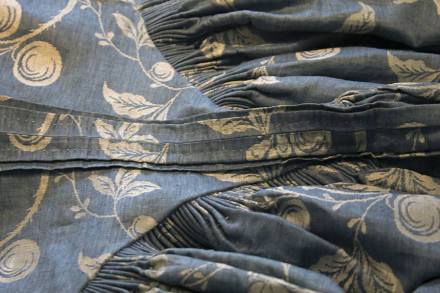
So what, you might ask? And so would I have, until I got a comment on one of my pictures on Facebook: “I thought they didn’t do cartridge pleating in the 18th century“.
I did not know this, and my first thought was: “Obviously they did, look at this dress“.
But once I knew this, I saw many more people talk about how cartridge pleating was just not done on these gowns (or any 18th century gown, for that matter). And these were people who I’d consider experts, long-term costumers and reenactors who had seen many original garments. In short: people much more experienced than me in 18th century dress.
Instead of cartridge pleating, the way to attach the skirts was by knife pleating, which is done by folding the fabric into one direction, stitching it on flattened through all layers. Like I did with my own silver gown: (even though here, the skirt was cut separately from the bodice.)
Or on this original gown sold by Vintage textile.com
So maybe the blue gown was just an oddity? That happens, you can often find single exceptions to a rule, and one counter-example does not prove something is commonly done. Maybe the person for who this dress was made just had odd taste?
Except that I also visited more exhibitions around the country. And I kept seeing Anglaise’s with what seemed like cartridge pleated skirts. From the outside, so it’s more difficult to be sure, but it certainly looks a great, great deal like cartridge pleating to me. This blue gown seemed increasingly less an oddity, and increasingly more like a very typical example.
These are pictures of the 4 gowns I’ve seen which seem to be cartridge pleated. Of all of the Anglaises I saw with folded back pleats and where I could see the skirt attachment clearly, this is 100% of them. I don’t doubt there’s English gowns in Dutch collections which clearly show knife pleats. But I haven’t seen any in person.
So what’s true here? Were these experts wrong in saying there was no cartridge pleating? Or was I seeing all of these wrong? My theory is that it’s neither, and although I cannot be 100% sure, what seems most likely to me is this:
Cartridge pleating your skirts was a typically Dutch thing to do. It was normal in the Netherlands, despite not being at all fashionable in France or England (and, therefore, the US).
This fits with the fact that 1. All the experts I’ve heard the ‘no cartridge pleating’ from are speakers of English and most familiar with English and American collections. And 2. All these examples of cartridge pleating occur in Dutch collections. (I haven’t seen enough items from other countries/cultures to know if it extents beyond the Netherlands, but if anyone does I’d love to learn more!). I proposed this theory to the same experts on Facebook, and the general consensus was that this is probably correct. (I was not imagining things, yay!)

A very Dutch ensemble? A chintz gown with cartridge pleated skirt, over a blue satin corded quilted petticoat. (Centraal museum Utrecht)
There are two additional things which seem to support this theory. The first is that nearly all the cartridge pleats I’ve seen occur on dresses which share some other shared characteristics. This type of dresses seems to exist much more in Dutch collections than in others, indicating that this style was popular mainly in the Netherlands.
Specifically, all of these gowns have the pleated back (even though by the 1780’s, a back with cut back panels became more popular), they have robings in the front (folded edges running over the shoulder) which run all the way into the skirt, and the space between the robings is filled with either 2 sewn-in panels closing center front, or several sewn-in trips of fabric closing center front. Although you see robings a lot in the 1740’s and 1750’s in England in particular, these robings typically stop at the bottom of the bodice, and the center front of these is open (to be worn with a stomacher). Moreover, this style had become very old-fashioned by the 1780s, while a fair number of these Dutch gowns is dated that late.
This picture points to the robings and cf closure on the green gown.
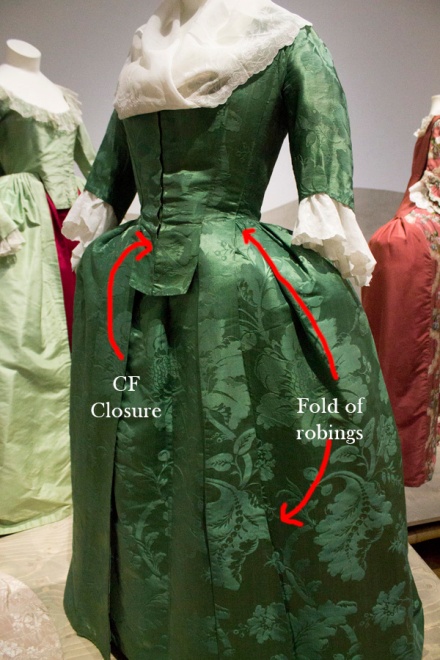
And this picture shows the lining of one of the strips closing the bodice on the first blue gown. You can see the (in the picture) horizontal fold above this, which is the robing.

There are more examples in Dutch collections that I haven’t seen in person, such as this lovely red chintz dress:
For more examples of this style, see this pinterest board!
The second is that we know from some contemporary accounts that Dutch women liked their skirts big, and cartridge pleating is particularly suited making very full skirts stand out even more. The book ‘Aangekleed gaat uit’ has a reference to women mocking others for their lack of petticoats, and the book ’18th century Dress in Europe’ has a quote of a contemporary (non-Dutch) traveler remarking on the same thing.
So, the moral of this story? For me, it drove home a couple of things. Firstly, that the further you go back in time, the more important it becomes not to generalize knowledge on one region to another. Yes, people traveled and communicated, but in the 18th century, there were still loads of characteristics of dress common in one region/country but not in the other. The second is that it’s important to ensure that ‘rules’ don’t make you blind to what’s right in front of you. A single exception does not prove a general rule is false, but it could be a sign that there’s more to the story. And finally, that there is definitely such a thing as cartridge pleated skirts to Anglaises, as long as you are talking about a Dutch context, even if there isn’t in a French/English one.
I also now want to make my next Anglaise with cartridge pleats!
Because it’s so pretty!
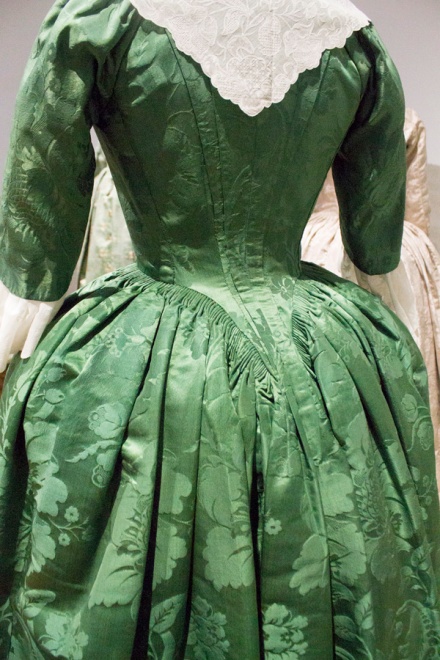
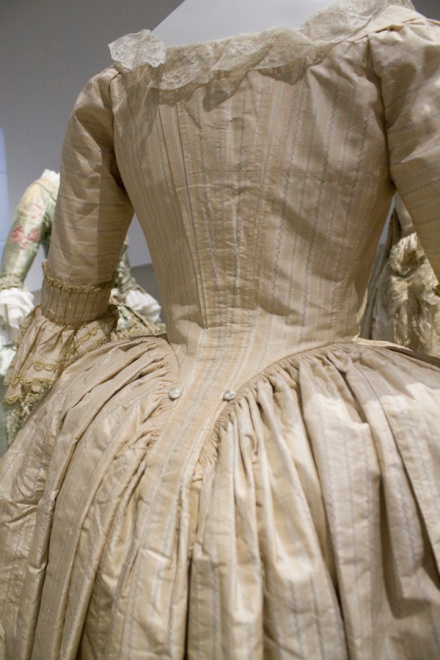
Edit per 10-01-2020: Two pictures of a silk dress from the Kunstmuseum Den Haag, seen early 2020 which shows cartridge pleats as well. This dress has the same characteristics as all the others, folded back pleats and folded robings in front.
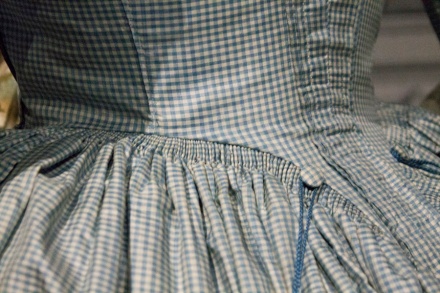
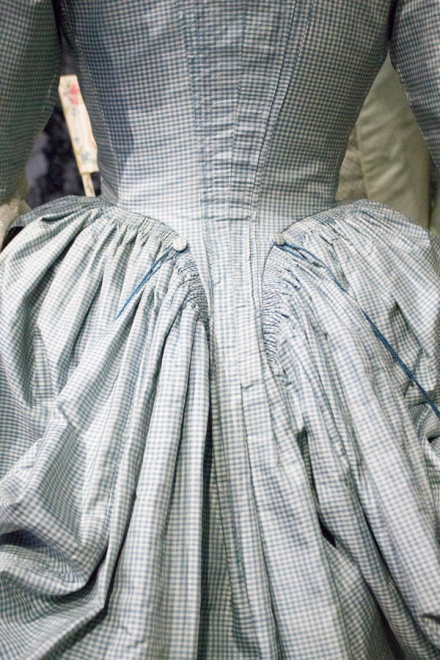













Thank you for researching this. I’d wanted to do cartridge pleats on an Anglaise because they add such fullness.
They are quite beautiful! I really want to make one of this type of dress now, as it’s such an interesting mix of special characteristics with the long robings and cartridge pleats.
In the short time I’ve been costuming I’ve learned that it’s best to remove the words such as “No and Never done” from my vocabulary. Last September I traveled to the La Maison du Boutis museum in Calvisson, France. They have a large collection of 17th and 18th-century clothing. There I saw bag lined Caraco jackets and other sewing techniques that I had been told previously were “Never done”. The truth is until someone invents a time machine we just don’t really know. I truly loved this post. It was so informative and full of lovely eye candy. Thank you!
It’s definitely nearly impossible to say things weren’t done if they were not technically impossible. But I also see people taking this to say: ‘so just do whatever’, which I also don’t really like as it implies research doesn’t matter somehow? These dresses show that this technique we didn’t know was used like this, did exist. But also with a very specific context, and specific location and style of dress. So I definitely distrust people who say ‘never done’, but if we want to get an idea of what was common single exceptions also are not helpful. And the further back you go, the more important location becomes :).
Dank je wel voor het delen! Heel interessant. Ben net bezig met een robe a l’Anglaise
What a nifty discovery. You’ve laid out a great case: you’ve shown examples, noted the technique’s previous use, noted other similarities in the gowns’ styling, and hypothesized a cause based on evidence from the day: the preference for very full skirts. [Fist pump] Hooray for sharp eyes; hooray for documentation!
I can imagine that there were many other local, regional, and national variants and preferences in 18th century Western costume. Patterns of Fashion V certainly picks up on variants in stays.
Part of the issue is a language thing, I am sure — the costuming community that so many of us belong to uses English as a lingua franca, and English sources, and French (as the center of Western fashion) predominate. The Bassermann-Jordan book (German) and Tidens Toj (Swedish) collection document really cool 18th century costumes: what else is out there, I’ve often wondered?
Very best,
Natalie in KY USA
Thank you!
I think these little regional differences are so fascinating, and truly an area which can be explored so much further. I myself know that I’m much more aware of the English and French collections than of anything else outside of the Netherlands, it truly makes me wonder how much more we have to learn! Language definitely matters, the Netherlands is one of the best places for describing things to an international audience (we’re so small it’s almost a habit), and even then I know of a lot of resources which must be very difficult to truly access if you don’t speak the language.
It also makes me really excited for Patterns of Fashion 6, as that will be on 18th century European women’s dress (PoF 1 was on English dress), and I’ve seen pictures of the people at the School of Historical dress (who are writing the book) going to different places to take patterns. I can’t wait to see what they come out with!
Thank you for a carefully considered article. It is nice to see a well-informed costumer demonstrate the variations in design by region. And the gowns you show are pure eye candy!
Thank you, and you are very welcome!
Fascinating! Thank you for sharing your thoughts with excellent pictures. It certainly looks like all of those examples are cartridge pleated to me, too. And it makes sense that that will produce more fullness than knife pleats. It will be fun to see you create a dress with cartridge pleats!
Best,
Quinn
You’re very welcome!
I have been sewing most of my life and my great grandmother was a dressmaker in the mid 1800’s. My experience and “research” has revealed that a period fashion dictates the style and look, but construction and materials are limited to experience, supply and expertise. Sewing like any craft is only limited by the artisans imagination. Our imagination leads to innovation in technique to achieve a particular look or style. To claim that a stitch or technique is/is not of a particular time, limited by what is observed is absurd. We all know that we are looking at only a minuscule sample of anything. For anything contracted today to be historically correct would have to use not only actual tools of that time but materials.
There is no such thing as ‘true accuracy’, no. But that doesn’t mean that ‘anything goes’ either. Some things were commonly done, some things were very rare. I think diving into that is what truly helps us understand how/why things were made the way they were. There are no black and whites, which is why research is so very interesting and relevant. We cannot claim something wasn’t done if it was physically possible, but we can definitely observe that it doesn’t exist in extant garments, and I do think it is relevant to make that distinction. Not to claim that it didn’t exist, but to get an understanding of what was common and what was not. In my experience, the black and white thinking can easily lead to either shaming others about not being correct, or to dismissing research as irrelevant, neither of which I am happy to see.
Hello there! I might be a bit late to this post, but I was doing some research on 18th-century gowns as I am making one! I was actually researching about the white undersleeves, (the ones that are fluffy… I was curious to know if they were removable, or if a woman would change them out depending on the occasion,) ANYWHO, that’s beside the point! I was happy to stumble across your well-organized research on the pleating of these gowns. I personally dont like how knife pleats look, but I LOVE cartridge pleats and jump at ANY chance that I get to do them! Thanks to your information I now have an excuse to do cartridge pleats on my gown! (yardage permitting of course!
Hi, thank you! I think you are looking for information about engageantes? That is the name often used for the frilly lace undersleeves in the 18th century :). Knife pleats look a bit flatter and wider than cartridge pleats mostly! I find it particularly interesting how the cartridge pleats really seem to have been used for this very specific Dutch style of dress, together with the robings, center front closure and pleated (“English gown”) back.
Ah yes! Engageantes! That’s what they are called! Thanks for that! 3 am googling wasnt proving to be very successful! Good news is that I barely had enough material to cartrige pleat my gown! I have pleated and sewn the one side, and need to get the other side finished tomorrow! After that, I’ll add the engageantes, and ties to pull up my skirt and consider this project finished! Thanks again for all your research! The finished gown will be on my Instagram! (@summers_stitchery)
Pingback: Beautiful Banarasi Silk – Silk and Sass
Cartridge pleating started long – long before 18 century. Turn to nowerdays German territory for the research. This technic was known from the late middle ages, late 15-th and beginning of 16 century, full of the Reformation and 100- year war. See the paintings of Cranagh and also Dürer where the dresses are all in this technic.
Marika.
I know, there’s a lot of paintings where it shows on 17th century dresses as well :). The claim from the other experts which I talk about was never that people in the 18th century didn’t know how to cartridge pleat, just that it wasn’t the way people normally pleated this specific type dress.
Hello, I am just about to start my third attempt. I pin pleated the first two and the petticoats,this time I have lots of very soft fine cotton and would like to cartridge pleat. My query, do I measure out 200cm of sewing cotton for each row of pleating? Also my last project has failed a bit- bodice fitted beautifully but when I put the sleeves in it completely changed the fit, now gapes at the front and doesn’t meet at the back. I had already trimmed close and bound the sleeve edges so I don’t know if I can take them of and re-do successfully. Lovely pale gold silk taffeta someone gave me, used every square inch so can’t re-make! Caroline.
Hi, in general I’d start with how wide the final pleated area needs to be, in theory you only need about that much thread for the pleats (+ some extra for safety + extra for tying up etc). However, if you have more, you can also start with the full width of fabric so you can actually run the pleats entirely before you start gathering up. You don’t want to gather up the first row before you’ve pleated the second, so if you use the first method you need to do each row half-way, gather, continue (if that makes sense). Good luck.